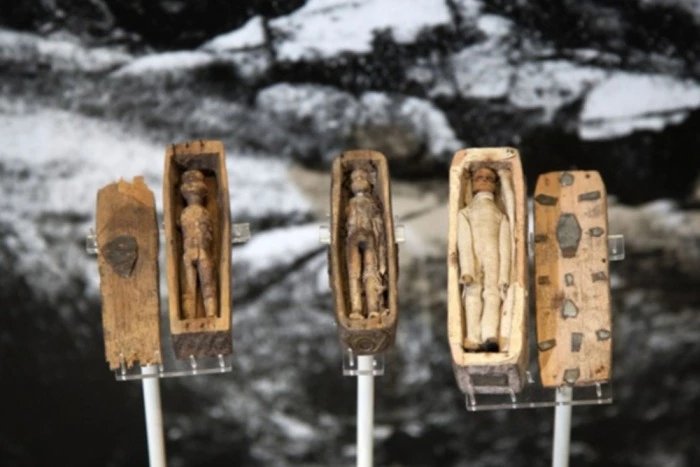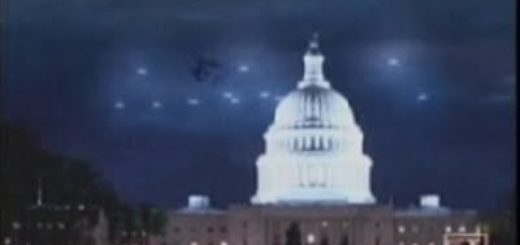17 Mysterious Miniature Coffins In Scotland Remain An Unsolved Enigma
About 200 years ago, seventeen concealed miniature coffins were discovered in a cave in Edinburgh’s Arthur’s Seat, Scotland. No-one knows who put the tiny coffins there and why. It’s a most curios find that to this day remain an unsolved enigma.

It all started in June 1836, when three Scottish boys who were out hunting rabbits discovered a small cave in the rock, hidden behind three pointed slabs of slate. Concealed within were 17 miniature coffins.
According to Charles Fort, (1874-1932), an American writer and researcher who specialized in anomalous phenomena the coffins were only “three or four inches long.
In the coffins were miniature wooden figures. They were dressed differently in both style and material. There were two tiers of eight coffins each, and a third one begun, with one coffin.
That the coffins had been deposited singly, in the little cave, and at intervals of many years. In the first tier, the coffins were quite decayed, and the wrappings had moldered away. In the second tier, the effects of age had not
On July 16,1836, the Scotsman reported several of the figures were either badly damaged or lost altogether as the decrepit-looking cache provided convenient fodder for the boys to pelt one another with. Fortunately, some of the coffins were still intact and they were sold to a Robert Frazier, a South Andrews Street jeweler and private collector where they remained until being donated to donated to the National Museum of Scotland in 1901. Only eight figures, in varying states of decay, survive.
The human effigies were all dressed in different garments. Obviously, they must have been created to represent different individuals.According to the Scotsman, the figures “were dressed from head to foot in cotton clothes, and decently laid out with a mimic representation of all the funereal trappings which usually form the last habiliments of the dead.”
Ever since the coffins discovered, experts and laymen alike have put forward a number of a number of interesting and sometimes even incredible theories that attempt to explain who placed the artifacts in the cave and why.
Scotland has long been a country where many people were and some still are superstitious.
Satanic spell-manufactory!’ cried The Scotsman, the first paper to report the tale, in an article published on 16 July 1836:
“Our own opinion would be – had we not some years ago abjured witchcraft and demonology – that there are still some of the weird sisters hovering about Mushat’s Cairn [sic] or the Windy Gowl, who retain their ancient power to work the spells of death by entombing the likenesses of those they wish to destroy.
Later different theories were presented. Some attempted to explain the existence of the coffins as a result of witchcraft while others suggested that they were perhaps kept by sailors to ward off death.
Another widely held belief is that each of the figures were designed to commemorate the victims of the infamous serial killers Burke and Hare. The murderous duo had ended the lives of precisely seventeen Edinburgh citizens less than a decade prior to the boys’ discovery on Arthur’s Seat.
According to the National Museum of Scotland “the figures all appear to be made by the same hand, although it’s possible the coffins were crafted by two different people.
Some of the materials and tools used – wood, iron embellishments, nails, a sharp, hooked knife – indicate the coffins could have been fashioned by a shoemaker.
The figures seem to form a set, and their upright bearing, flat feet and swinging arms suggest they may have been toy soldiers. Their eyes are open, making it unlikely they were originally designed as corpses.
Some of the figures are missing their arms – perhaps removed so that they would fit in the coffins.
The fabric the little bodies are dressed in dates from the early 1830s, so they hadn’t lain buried for more than six years.”
Today, the remaining eight coffins and their contents are on display to the public at the National Museum of Scotland on Chambers Street.
Written by Ellen Lloyd – AncientPages.com
Copyright © AncientPages.com & Ellen Lloyd All rights reserved. This material may not be published, broadcast, rewritten or redistributed in whole or part without the express written permission of AncientPages.com and Ellen Lloyd
About the author:Ellen Lloyd – is the owner of AncientPages.com and an author who has spent decades researching ancient mysteries, myths, legends and sacred texts, but she is also very interested in astronomy, astrobiology and science in general



 Creators of mankind
Creators of mankind Description of “Tall white aliens”
Description of “Tall white aliens” Where they came from?
Where they came from? About hostile civilizations
About hostile civilizations The war for the Earth
The war for the Earth “Tall white aliens” about eternal life
“Tall white aliens” about eternal life Video: “Nordic aliens”
Video: “Nordic aliens” Aliens
Aliens Alien encounters
Alien encounters The aliens base
The aliens base UFO
UFO Technology UFO
Technology UFO Underground civilization
Underground civilization Ancient alien artifacts
Ancient alien artifacts Military and UFO
Military and UFO Mysteries and hypotheses
Mysteries and hypotheses Scientific facts
Scientific facts


















